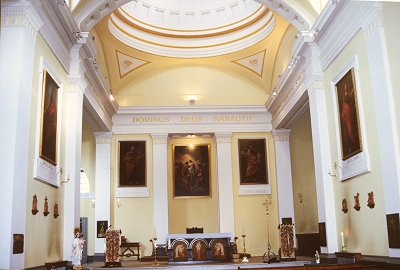Anti-Catholic agitation in
Wolverhampton (part 3)
The restoration of the
Catholic hierarchy
In fact, it was in some way the result of this mass immigration of the
Irish into England that the Restoration of the Catholic hierarchy was
implemented. As Bishop Ullathorne explained in a letter to The Times,
"Now the increase in Catholics, not merely by conversions but far more
by the vast influx of Irish subjects, necessarily demanded an increase
of Bishops". [WC 30th Oct 1830] The Wolverhampton Chronicle
saw, more sinister motives in the move. "The Church of Rome boldly and
unequivocally asserts its right not even to co-ordinate ecclesiastical
authority, not even to rival rule, but to absolute and unreserved
authority over the Protestant Establishment of the realm." [WC 6th
Oct 1830].
 |
The interior of Ss Peter
and Paul's Church. |
This view brought cries of protest from the two Catholic priests,
O'Sullivan and Longman, who accused the editor of "trying to excite
religious prejudices and mislead those who do not understand the
question". As Bishop Walsh had done in 1829, the priests explained that
"in temporal matters, we, as Englishmen, acknowledge no allegiance but
to our beloved sovereign, Queen Victoria; we hold her supreme; we pay
homage to her alone ...." They also argued that the re-establishment of
the hierarchy affected Catholics alone in a spiritual and ecclesiastical
manner, and that it introduced a greater element of democracy into the
Church since it gave the Roman Catholic clergy the opportunity of
electing their own Bishops Ordinary. In this respect it reduced the
power of the Pope, who had previously possessed the sole right of
selecting the Vicars Apostolic in this country. Reflecting their wish to
maintain good relations between Catholics and non-Catholics in the town,
their letter ended:
" .... we deeply regret the false alarms and misconceptions which
have excited an apparently unfriendly and uncharitable feeling
towards Roman Catholics on this subject; the more so, as we
ourselves have lived, and desire to continue, on terms of friendly
intercourse and brotherly love with our fellow townsmen of every
denomination". [WC 13th Nov 1830].
As the controversy over the Restoration of the Catholic hierarchy
gathered momentum at the beginning of November 1850, it was not
surprising that Guy Fawkes Night celebrations should have been used by
some opponents to give vent to their feelings. Though there were no
effigies burned in Wolverhampton, this was not the case in many other
places including Salisbury, Peckham, and Ware. In Ware a stuffed donkey,
representing both Cardinal Wiseman and the Pope, "was first hanged from
a gallows before being burned to roars of execration from the crowd".
[Gordon Albion "Restoration of the Hierarchy in 1850" The English
Catholics 1850 – 1950, [1950] p.101].
On Friday 15 November 1850, a series of anti-Catholic lectures began in
Wolverhampton when the Rev Dr Bryson, of the Scottish Presbyterian
Church, addressed almost 800 people who were packed into the schoolroom
of the Darlington Street chapel. His two hour lecture was enlivened by
the inclusion of some clever and witty satire. He stated that, "to the
Queen of England alone belonged the right to confer English titles. In
short, if Britannia rules the waves, she has the right to 'rule the
sees'." Bryson won loud applause from his audience as he recited his
verse: [WC 20th Nov 1850].
"When Pius to this country sent
A Cardinal with powers full,
His Popeship in his rashness meant
To coin the nation by his bull -
But We've a Bull to match the Pope's,
A sturdy John, who'll not be slow
To crush the proud Archbishop's hopes.
Is he a Wiseman? Oh: no, no."
There were so many anti-Papal lectures being held in and around the
town that the report of Bryson's talk was relatively brief, the editor
of the Chronicle explaining that "the crowded state of our columns with
reports of similar meetings will not permit us to give a fuller account
of this lecture".
Within days a petition containing 200 signatures was received by the
Mayor, Joseph Walker, requesting him to convene a meeting in the town to
discuss the matter of the "Papal Aggression". This was duly held on
Tuesday 26 November in the Assembly Rooms, Queen Street, in front of a
large gathering which included three Catholic priests, Longman,
O'Sullivan, and O'Donnell. Despite the arguments put forward by Father
O'Sullivan, those present overwhelmingly agreed to address "her most
gracious majesty on the present aggressions of the Pope of Rome in the
promotion of a Papal hierarchy for the country, and further to take such
steps as the present crisis may require ...." [WC 27th Nov
1850].
For the first time there mere signs of frustration displayed by the
Irish Catholics in the town who were not as willing as their English
co-religionists to react passively to these attacks upon their faith.
When, on Monday 9 December 1850, a crowded meeting at the Assembly Rooms
was addressed on the evils of Popery by Rev Teodor, who claimed to be a
former Romish Archdeacon of the diocese of Poldachia in Silavonia, a
young Irish labourer interrupted on several occasions, asking for the
right of reply. His plea was denied, and he was eventually thrown out of
the room by the Chief Coristable. [WC 27th Nov1850].
|

